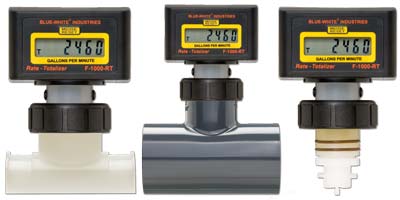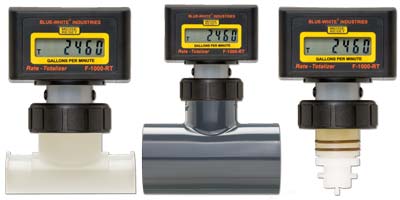Paddlewheel Flow Meter Models
Blue-White Industries supply paddlewheel flowmeter models that incorporate the most desirable features required for high quality sensors. With the advanced technologies being incorporated in flowmeters in the modern time, a greater degree of precision is provided for your dollar. Simple installation is also allowed for as these flowmeters can be applied vertically or horizontally without harming the overall performance. Unmatched versatility that make our flowmeters remarkable efficient with any type of fluid has made them the most in-demand of their kind.
F-2000
- Panel, Wall or Pipe Mount
- Flow Ranges: 0.4 - 8,000 GPM
- Battery Operated
F-1000
- Display Mounted on Pipe Fitting
- Flow Ranges: 0.4 - 8,000 GPM
- Battery Operated
MICRO-FLO
- Sensor or Panel / Mount Display
- Transformer Power Required
- Flow Rates: 30 - 7,000 ml/min
Pure Aqua has over 20 years of experience as a global provider of Paddlewheel Flow Meter Models, which are highly reproducible, robust sensors that deliver amazing value with very little upkeep and are easy to install with time-honored reliability and performance.
Paddlewheel Flow Meter Models are manufactured by Blue-White Industries and provide terrific performance to users and various complete pipe water flow applications, including offering simple installation and battery-powered features. The advanced materials used with paddlewheel flowmeters are extremely durable and ensure a long service life, even under harsh, corrosive conditions. There is a reset button for the totalizer and a easy to read LDC display sign that notifies the user of both overall flow and rate of flow. The paddlewheel is also capable of being quickly uninstalled for maintenance requirements or replacement.
How Paddlewheel Flowmeters Work
Paddlewheel flowmeters utilise the fluid's mechanical power to spin a paddlewheel in the flowing fluid. To convert power from the fluid into rotational energy, paddles on the rotor are introduced into the flow. Bearings support the rotor shaft. The paddlewheel rotates clockwise in relation to the speed of the fluid. Shaft rotation can be detected mechanically or by watching the paddles move. Magnetic detection of paddle movement is common, with each paddle or implanted bit of metal generating a pulse. More pulses are produced as the fluid travels quicker. The pulse signal is processed by the transmitter to identify the fluid flow.
Paddlewheel Flowmeters: How to Use Them
The velocity of fluids in pipelines, such as pharmaceuticals, water, and liquids, are measured using paddlewheel flowmeters. When properly placed, high accuracy is possible. These flowmeters are impacted by viscosity changes because they measure flow at the border of the flow profile. The most typical application is in a system where the liquid is similar to water and additional variables like conductivity, pressure, temperature, and levels are measured. This insertion device has pressure and temperature limits, but it is quite adaptable.
Cautionary Considerations for Paddlewheel Flowmeters in Use
At low flow rates, paddlewheel flowmeters experience a decrease in precision, which delays the rotor. Ensure these flowmeters are set to run at a frequency of as low as 5%. Strong operation of paddlewheel flowmeters can lead to early degradation and/or failure. When monitoring liquids, be cautious because bearing corrosion can enable the flowmeter to become erroneous and fail. Replacing the sensor may be required on a regular basis in particular applications, increasing maintenance expenses. It is not advised to use this product in unclean fluids. In conclusion, paddlewheel flowmeters have working components that degrade through time and usage.
A sudden change from gas to flowing fluid must be prevented as it can mechanically strain the flowmeter, reduce precision, and/or destroy it. These situations are most common while the pipe is being filled and when slug flow is present. Flowmeters can also be erroneous when there is a two-phase flow.
-
Systems
-
Parts
-
Expertise
- All Expertise
- Engineered Solutions
-
Water Treatment Applications
- Hydrogen Production
- Poultry
- Solar Panels
- Agriculture
- Desalination
- Golf Courses
- Lithium Mining
- Water Stores
- Window Washing
- Aerospace
- Boiler Feed
- Dairy
- Disaster Relief
- Drinking Water
- Environmental
- Fish Hatcheries
- Food & Beverage
- Hospital
- Hotel
- Ice Making
- Laundry
- Marine
- Military
- Mining
- Municipal
- Offshore
- Pharmaceutical
- Power & Energy
- Refinery
- Restaurants
- Semiconductor
- Spot Free
- Wastewater
- Water Treatment Projects
- Regional Expertise
-
Resources
-
About Us
 ENGLISH
ENGLISH
 ESPAÑOL
ESPAÑOL ???????
??????? PORTUGUÉS
PORTUGUÉS FRANÇAIS
FRANÇAIS



